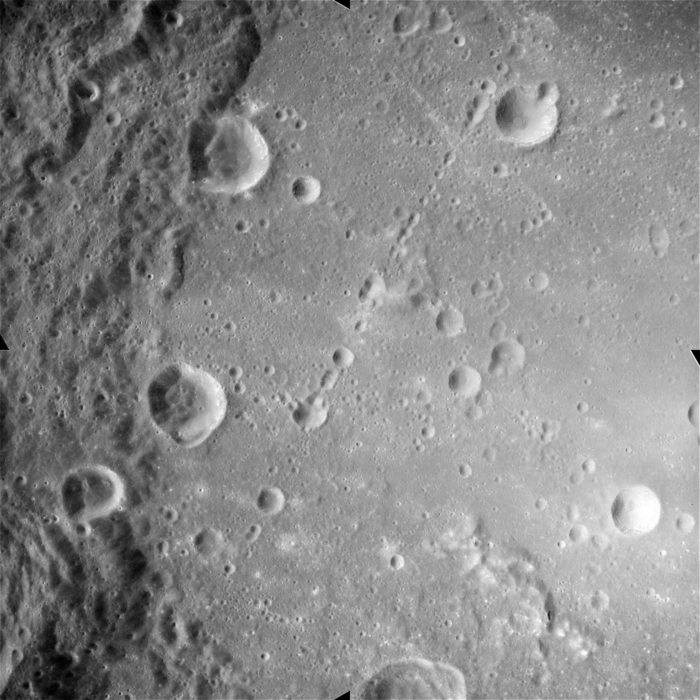
| Project Home | About the Scans | Browse Gallery | Image Map | Support Data | Resources | Ephemeris |
Featured Image - (11/25/2008)
Light Plains in Mendeleev
Mendeleev crater (named after Dimitri Mendeleev, the inventor of the periodic table of elements) is a very large, Nectarian-age crater on the farside of the Moon near the equator [AS16-M-0063; Figure 1]. At approximately 313 kilometers in diameter, it is almost large enough to be a small basin. The interior contains many younger craters, inlcuding a chain of small craters named the Catena Mendeleev, but also features a very smooth floor filled in with a light plains material. In general, this material is characterized by its smooth surface and intermediate albedo (brighter than basaltic mare material, but not as bright as highlands material). Although infrequent in occurance, light plains are found elsewhere on the Moon, most notably in the Cayley formation near the Apollo 16 landing site. Because human explorers have never visited Mendeleev, the origin of the light plains material is enigmatic. One hypothesis is that the Mendeleev light plains deposits are impact melt generated by a large impact. However, there is also evidence to support the idea that the light plains formed through volcanic activity. Regional mapping using orbital remote sensing data suggests that the light plains deposits are not related to just one or two single impact events, but span a larger time period (Neukum et al). The data to be returned by the forthcoming Lunar Reconnaissance Orbiter mission and subsequent human lunar exploration will be required to pinpoint the origin of the light plains material.
Figure 1. The smooth floor of Mendeleev includes many craters and is approximately 4.2 to 4.3 billion years old, as shown by crater counts. Catena Mendeleev is the linear crater chain stretching NE to SW across crater Mendeleev. Terracing of the crater wall is visible in the upper left hand corner. (Apollo Image AS16-M-0063 [NASA/JSC/Arizona State University])
Figure 2. Crater Mendeleev is in the upper right hand corner of the image, located at 6.3 N, 142.6 E. Compared to the surrounding highland material, the interior of Mendeleev is quite smooth and slightly darker (lower in albedo). (Digital Lunar Orbiter Photographic Atlas of the Moon, Photo Number I-136-M. [NASA/LPI])
Sources:
Apollo Over the Moon: A View From Orbit (1978) H. Masursky, G.W. Colton, F. El-Baz, eds. NASA Sp-362. http://www.hq.nasa.gov/office/pao/History/SP-362/contents.htm
Digital Lunar Orbiter Photographic Atlas of the Moon Photo Number I-136-M
Lunar Light Plains: Ages and Composition (1987) S. Engel, G. Neukum, R. Jaumann and E. Nagel. LPSC. pp: 262
Different ages of lunar light plains (1977) G. Neukum, The Moon: 383-393.
Tweet
![]()

|
|
Space Exploration Resources |
|
 LPI LPI
|

